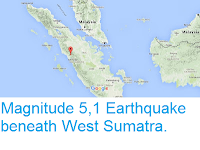The Middle InfraRed Observation of Volcanic Activity (MIROVA) monitoring system, which uses data from the Moderate-Resolution Imaging Spectroradiometer (MODIS) system on the Terra (EOS AM) and Aqua (EOS PM) satellites detected a thermal anomaly on Mount Krakatau, a volcanic island located in the Sunda Strait between Sumatra and Java, that famously exploded in 1883, killing over 36 000 people
(possibly over 120 000), largely through a series of tsunamis, on Saturday 18 February 2017 suggesting a new bout of activity was staring on the island. On Monday 20 February a witness in the region contacted the Volcano Discovery website, confirming having witnessed volcanic activity on the 19th.

Eruptive activity on Mount Krakatau on 19 February 2017. Volcano Discovery.
Krakatau is located to the north of the Sunda Trench, along which the
Australian Plate is being subducted beneath the Sunda Plate, on which
the island sits. As the Australian Plate is subducted it is partially
melted by the friction and the heat of the planet's interior. Some of
this melted material then rises through the overlying Sunda Plate,
fuelling Krakatau and the volcanoes of Sumatra and Java.
The Subduction zone beneath Sumatra. NASA/Earth Observatory.
See also...
Follow Sciency Thoughts on Facebook.







